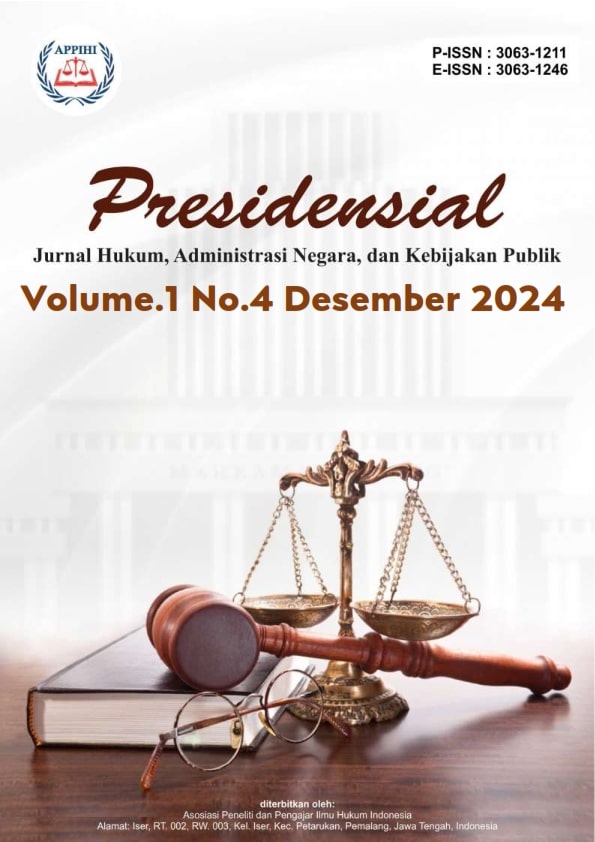Gaya Kepemimpinan Perempuan dalam Jabatan Publik
Studi Kasus pada Kantor Dinas Kesehatan Kota Surakarta
DOI:
https://doi.org/10.62383/presidensial.v1i4.270Keywords:
Leadership style, Women, Public officeAbstract
The aims of this research are To find out the leadership style of women in the Surakarta City Health Office,To find out the role of women leaders based on leadership style in public office, To find out the challenges of women leaders in public office. This research uses a qualitative research method with a case study approach. The source of this research is the actions and habits of the Head of the Surakarta City Health Service, which were obtained through observations of the work environment of the Surakarta Health Service, in-depth interviews with various related sources, and documentation from biographies and social media. The validity test used to test the validity of this research uses triangulation of methods and data sources. The results of this research are as follows. First, the Head of the Surakarta Health Service has various elements of leadership style, including feminine, masculine, transformational, and transactional leadership styles. This can be seen from his actions and policies in leading the agency. These results explain that there is no relationship between gender and the choice of leadership style. Second, the Head of the Surakarta Health Service has a big role in motivation and is also a good role model for the agency, so the Surakarta Health Service becomes the best agency in the Surakarta City government. Third, as a woman, the Head of the Surakarta City Health Service does not experience problems or obstacles caused by gender differences. These results show no differences in the challenges faced by men or women.
Downloads
References
Abalkhail, J. M. (2017). Women and leadership: Challenges and opportunities in Saudi higher education. Career Development International, 22(2), 165–183. https://doi.org/10.1108/CDI-03-2016-0029
Block, C., Koch, S., Liberman, B., Merriweather, T., & Roberson, L. (2011). Contending with stereotype threat at work: A model of long-term responses. The Counseling Psychologist, 39(4), 570–600.
Carli, L. L. (2001). Gender and social influence. Journal of Social Issues, 57(4), 725–741. https://doi.org/10.1111/0022-4537.00238
Fitriani, A. (2015). Gaya kepemimpinan perempuan. TAPIs, 11(2), 3–5.
Henriyani, E. (2020). Peran pemimpin visioner dalam mewujudkan inovasi pelayanan publik. Jurnal Moderat, 6(2), 436–443. https://jurnal.unigal.ac.id/index.php/moderat/article/view/3427
Hoyt, C. L., & Murphy, S. E. (2016). Managing to clear the air: Stereotype threat, women, and leadership. Leadership Quarterly, 27(3), 387–399. https://doi.org/10.1016/j.leaqua.2015.11.002
Jin, Y. (2010). Emotional leadership as a key dimension of public relations leadership: A national survey of public relations leaders. Journal of Public Relations Research, 22(2), 159–181.
Jyoti, J., & Dev, M. (2015). The impact of transformational leadership on employee creativity: The role of learning orientation. Journal of Asia Business Studies, 9(1), 78–98. https://doi.org/10.1108/JABS-03-2014-0022
Koenig, A., Eagly, A., Mitchell, A., & Ristikari, T. (2011). Are leader stereotypes masculine? A meta-analysis of three research paradigms. Psychological Bulletin, 137(4), 616–642.
Luh Mutiara Devia Devi, P. (2019). Analisis gaya kepemimpinan perempuan bupati. CITIZEN CHAPTER, 1–7.
McKinsey & Company. (2018, October 6). Women in the workplace 2018. Retrieved from https://www.mckinsey.com/featured-insights/gender-equality/women-in-the-workplace-2018
Musa, A. E., Latiep, I. F., & Herlina, A. (2023). Peran kepemimpinan perempuan dalam birokrasi. Yogyakarta: PT. Nas Media Indonesia.
Musoli. (2021). Peran kepemimpinan perempuan, motivasi, dan disiplin kerja dalam meningkatkan kinerja karyawan. JPIM (Jurnal Penelitian Ilmu Manajemen), 6(1), 64–88.
Northouse, P. G. (2016). Leadership: Theory and practice (7th ed.). London: Sage Publications.
Place, K. R., & Vardeman-Winter, J. (2018). Where are the women? An examination of research on women and leadership in public relations. Public Relations Review, 44(1), 165–173.
Powell, G. N., Butterfield, D. A., & Parent, J. D. (2002). Gender and managerial stereotypes: Have the times changed? Journal of Management, 28(2), 177–193. https://doi.org/10.1177/014920630202800203
Rahayu, I. D., Musadieq, M. A., & Prasetya, A. (2017). Pengaruh gaya kepemimpinan dan program keselamatan dan kesehatan kerja terhadap motivasi kerja (Studi pada karyawan tetap Maintenance Department PT Badak LNG Bontang). Jurnal Administrasi Bisnis (JAB), 43(1), 1–9. http://administrasibisnis.studentjournal.ub.ac.id/index.php/jab/article/view/1688
Shapiro, J. R., & Williams, A. M. (2012). The role of stereotype threats in undermining girls' and women's performance and interest in STEM fields. Sex Roles: A Journal of Research, 66(3), 175–183.
Smirles, K. E. S., Basile, K. A., Aughenbaugh, A., Nasser, S., Logue, S., & Arteaga, L. (2020). Japanese women’s perceptions of gender roles and leadership and the effects of a Women & Leadership Course: A qualitative analysis. Women’s Studies International Forum, 80, 102359. https://doi.org/10.1016/j.wsif.2020.102359
Szczepańska-Woszczyna, K. (2015). Leadership and organizational culture as the normative influence of top management on employee behavior in the innovation process. Procedia Economics and Finance, 34, 396–402. https://doi.org/10.1016/s2212-5671(15)01646-9
Werder, K. P., & Holtzhausen, D. (2009). An analysis of the influence of public relations department leadership style on public relations strategy use and effectiveness. Journal of Public Relations Research, 21(4), 404–427.
Yulianti, R., Putra, D. D., & Takanjanji, P. D. (2018). Women leadership: Telaah kapasitas perempuan sebagai pemimpin. Politik dan Sosial Kemasyarakatan, 10(2), 14–29.
Downloads
Published
How to Cite
Issue
Section
License
Copyright (c) 2024 Rani Kasih Setianingsih, Cicilia Dyah S I, Susantiningrum Susantiningrum

This work is licensed under a Creative Commons Attribution-ShareAlike 4.0 International License.






